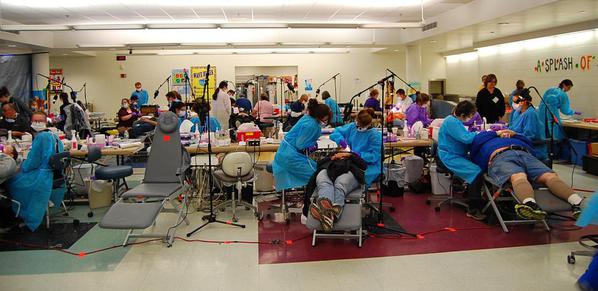Donald Rose has no teeth, but that’s not his biggest problem. A camouflage hat droops over his ancient, wire-framed glasses. He’s only 43, but he looks much older.
I met him one day in October as he sat on a tan metal folding chair in the hallway of Riverview School, one of the few schools—few buildings, really—in the coal-mining town of Grundy, Virginia. That day it was the site of a free clinic, the Remote Area Medical. Rose was there to get new glasses—he’s on Medicare, which doesn’t cover most vision services.
Remote Area Medical was founded in 1985 by Stan Brock, a 79-year-old Brit who wears a tan Air-Force-style uniform and formerly hosted a nature TV show called Wild Kingdom. Even after he spent time in the wilds of Guyana, Brock came to the conclusion that poor Americans needed access to medical care about as badly as the Guyanese did. Now Remote Area Medical holds 20 or so packed clinics all over the country each year, providing free checkups and services to low-income families who pour in from around the region.
When I pulled into the school parking lot, someone was sleeping in the small yellow car in the next space, fast-food wrappers spread out on the dashboard. Inside, the clinic’s patrons looked more or less able-bodied. Most of the women were overweight, and the majority of the people I talked to were missing some of their teeth. But they were walking and talking, or shuffling patiently along the beige halls as they waited for their names to be called. There weren’t a lot of crutches and wheelchairs.
Yet many of the people in the surrounding county, Buchanan, derive their income from Social Security Disability Insurance, the government program for people who are deemed unfit for work because of permanent physical or mental wounds. Along with neighboring counties, Buchanan has one of the highest percentages of adult disability recipients in the nation, according to a 2014 analysis by the Urban Institute’s Stephan Lindner. Nearly 20 percent of the area's adult residents received government SSDI benefits in 2011, the most recent year Lindner was able to analyze.
According to Lindner’s calculations, five of the 10 counties that have the most people on disability are in Virginia—and so are four of the lowest, making the state an emblem of how wealth and work determine health and well-being. Six hours to the north, in Arlington, Fairfax, and Loudoun Counties, just one out of every hundred adults draws SSDI benefits. But Buchanan county is home to a shadow economy of maimed workers, eking out a living the only way they can—by joining the nation’s increasingly sizable disability rolls. “On certain days of the month you stay away from the post office,” says Priscilla Harris, a professor who teaches at the Appalachian School of Law in Grundy, “because that's when the disability checks are coming in.”
[For more of this story, written by Olga Khazan, go to http://www.theatlantic.com/fea...n-in-america/384718/]




Comments (0)